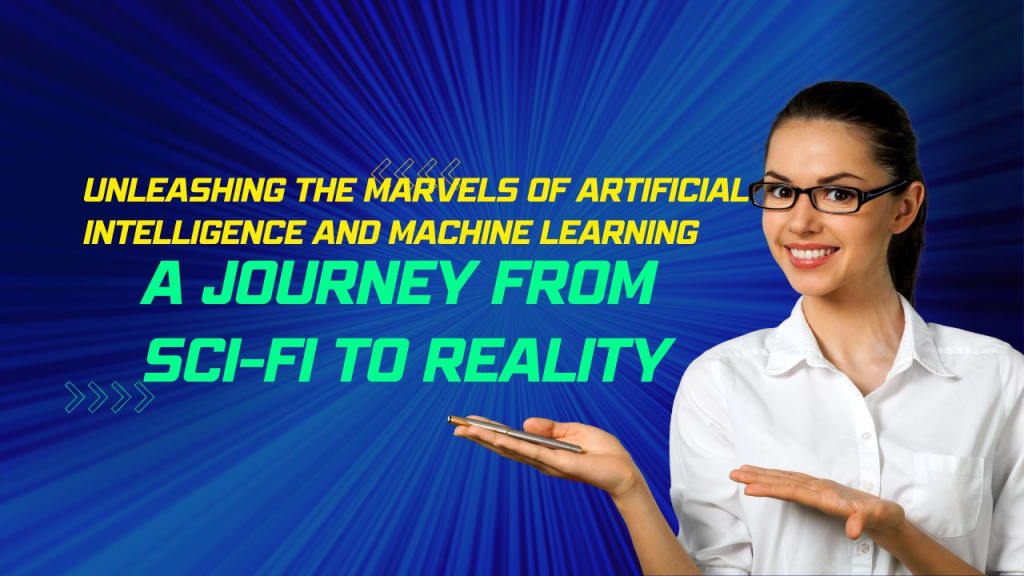Unleashing the Marvels of Artificial Intelligence and Machine Learning: A Journey from Sci-Fi to Reality
Artificial Intelligence and Machine Learning

Artificial Intelligence (AI) and Machine Learning (ML) have rapidly emerged as transformative technologies, revolutionizing various industries and reshaping our daily lives.
Their connection to the world of science fiction (sci-fi) has long captured the imagination of both researchers and the general public.
In this blog article, we will delve into the historical perspectives, fundamental concepts, practical applications, ethical considerations, and future possibilities of AI and ML.
Historical Perspectives

Early pioneers in AI research: The journey of AI dates back to the 1950s when pioneers like Alan Turing and John McCarthy laid the foundation for this field.
Turing’s groundbreaking work on computability and the concept of the “Turing Test” set the stage for developing intelligent machines. McCarthy, known as the “father of AI,” introduced the term “Artificial Intelligence” and contributed to the creation of the programming language LISP, widely used in AI research.
Evolution of AI from concept to application: From its humble beginnings in research labs, AI has evolved into a practical technology with real-world applications.
In the 1990s and early 2000s, AI witnessed significant advancements with the rise of expert systems, neural networks, and machine learning algorithms.
These developments paved the way for the integration of AI into various domains, such as healthcare, finance, and transportation.
Influence of sci-fi on AI development: Science fiction literature and movies have played a crucial role in shaping the vision and trajectory of AI research.
Films like “Blade Runner” and “The Matrix” have captured the public’s fascination with the concept of intelligent machines.
These depictions, though often sensationalized, have fueled scientific curiosity, inspiring researchers to explore the boundaries of AI capabilities.
What is Artificial Intelligence?

Defining AI and its core principles: Artificial Intelligence refers to the development of computer systems that can perform tasks that typically require human intelligence, including learning, problem-solving, and decision-making.
AI systems strive to emulate human cognitive processes, leveraging algorithms and data to achieve intelligent behavior.
Different types of AI technologies: AI can be broadly classified into three categories: narrow AI, general AI, and super intelligent AI. Narrow AI, also known as weak AI, focuses on specific tasks and operates within predefined boundaries.
In contrast, general AI aims to possess human-level intelligence and adaptability across various domains. Super intelligent AI goes a step further, surpassing human cognitive capabilities.
Importance of AI in various industries: AI has become a crucial driving force across numerous industries, fueling innovation and efficiency. In healthcare, AI facilitates advanced diagnostics, personalized medicine, and drug discovery.
Industries like finance and retail leverage AI for predictive analytics, fraud detection, and customer experience enhancement. Additionally, AI finds applications in transportation, agriculture, and cybersecurity, revolutionizing operations and decision-making processes.
The Fundamentals of Machine Learning

Introduction to Machine Learning: Machine Learning, a subset of AI, empowers computers to learn and improve from experience without explicit programming.
By utilizing algorithms, statistical models, and training data, ML systems acquire the ability to make predictions and take actions based on patterns and trends in the data.
Supervised vs. Unsupervised learning techniques: Supervised learning involves training ML models using labeled data, where the desired outputs or classifications are already known.
Unsupervised learning, on the other hand, operates with unlabeled data, allowing the model to uncover hidden structures or patterns independently.
Role of data in Machine Learning algorithms: Data is the lifeblood of ML algorithms, serving as the foundation for learning patterns and making accurate predictions.
The quality, diversity, and size of the dataset significantly impact the performance and reliability of ML models. Data collection, preprocessing, and augmentation are critical steps to ensure robustness and efficacy in ML applications.
The Cognitive Capabilities of AI

Natural Language Processing and Understanding: Natural Language Processing (NLP) equips machines with the ability to understand and interpret human language, enabling tasks such as speech recognition, language translation, and sentiment analysis.
NLP technology enables virtual assistants, chatbots, and voice-controlled devices to communicate and interact with users naturally.
Computer Vision and Image Recognition: Computer Vision enables machines to interpret and comprehend visual data such as images and videos.
Through techniques like image recognition and object detection, AI-driven systems can identify objects, recognize faces, and analyze visual content. Computer vision finds applications in augmented reality, autonomous vehicles, and medical imaging.
Emotional Intelligence and Sentiment Analysis: AI’s advancement has led to the development of emotional intelligence, enabling machines to perceive, understand, and respond to human emotions.
Sentiment analysis, a subset of AI, utilizes machine learning algorithms to analyze text, audio, or visual data and extract underlying emotions, opinions, or attitudes. This capability assists sentiment-driven decision-making and enhances user experiences.
Applications of AI in Everyday Life

AI-powered virtual assistants: Virtual assistants, like Amazon’s Alexa and Apple’s Siri, have become an integral part of our daily lives.
Employing AI and NLP, these assistants can perform tasks such as answering questions, providing recommendations, and controlling smart devices.
Virtual assistants streamline our interactions with technology, making information and services accessible through natural language conversations.
AI in healthcare and medical diagnostics: AI has made significant contributions to the healthcare industry, improving diagnostics, treatment plans, and patient outcomes.
Machine learning algorithms can analyze medical images, predict disease progression, and assist in drug discovery.
AI-powered healthcare systems enhance precision medicine, early disease detection, and personalized patient care.
AI-driven automation in industries: The integration of AI into industries has led to remarkable advancements in automation.
AI-powered robots and machines can carry out repetitive, labor-intensive tasks with efficiency and precision.
This automation revolutionizes manufacturing, logistics, and agriculture, augmenting productivity levels and reducing human error.
AI in Entertainment and Gaming

Enhancing user experiences through AI: Entertainment platforms leverage AI to enhance user experiences. Streaming services like Netflix and Spotify employ AI-based recommendation systems to personalize content recommendations based on user preferences and behavior.
AI algorithms enable content curation and personalized playlists, delighting users with tailor-made entertainment options.
AI-generated content in movies and video games: AI technologies are reshaping the landscape of content creation in movies and video games. AI algorithms can generate realistic special effects, procedural animations, and dynamic storylines.
Game developers integrate AI to create intelligent, lifelike non-player characters (NPCs) and adaptive gameplay experiences, adding depth and immersion to the gaming world.
Virtual reality and AI integration: The synergy between AI and virtual reality (VR) has unlocked novel possibilities in immersive experiences.
AI algorithms analyze user behaviors and responses, enhancing VR environments and interactions. AI-powered VR systems allow for realistic simulations, interactive storytelling, and customized user experiences.
Ethical Considerations in AI Development

Bias and fairness in AI algorithms: AI systems are susceptible to bias, reflecting the biases present in the data they are trained on. Ethical concerns arise when AI algorithms unintentionally perpetuate discriminatory practices or reinforce societal inequalities.
Ensuring fairness and reducing bias through transparent and diverse datasets, as well as ongoing algorithmic audits, is crucial to building responsible AI systems.
Privacy concerns and data protection: The widespread adoption of AI raises concerns about privacy and data protection. AI algorithms heavily rely on vast amounts of personal data, potentially compromising individual privacy.
Safeguarding user data, ensuring informed consent, and implementing secure data storage and processing protocols are essential for maintaining trust and protecting sensitive information.
Ethical guidelines for responsible AI deployment: Addressing ethical dilemmas in AI requires the establishment of comprehensive guidelines and frameworks.
Ethical considerations include ensuring transparency and accountability in AI decision-making, promoting human oversight, and addressing potential socio-economic impacts. Collaboration among policymakers, researchers, and industry stakeholders is vital to developing ethical AI practices.
AI and Robotics Integration

Advancements in AI-powered robotics: The integration of AI and robotics has accelerated the development of intelligent machines capable of perceiving, learning, and interacting with their environment.
Robotics advancements, coupled with AI algorithms, allow robots to perform complex tasks, navigate dynamic landscapes, and collaborate with humans in diverse settings.
Industrial applications of AI-embedded robots: AI-embedded robots are transforming industries by automating processes, improving safety, and increasing productivity.
In manufacturing, robots equipped with AI algorithms enhance efficiency, adaptability, and quality control. Collaborative robots, or cobots, work alongside humans, improving manufacturing workflows while minimizing risks.
Future prospects of human-robot collaboration: The future holds immense potential for human-robot collaboration. AI-powered robots can augment human capabilities, revolutionizing healthcare, space exploration, and rescue operations.
The collaboration between humans and robots paves the way for safer, more efficient processes and unlocks new frontiers in scientific research and exploration.
Challenges and Limitations of AI

Lack of interpretability in AI decision-making: One of the key challenges in AI lies in the lack of interpretability of decision-making processes.
Deep learning models, for instance, often function as “black boxes,” making it challenging to understand the reasoning behind their outputs. Ensuring transparency and explainability in AI algorithms is crucial for building trust and addressing concerns.
Cybersecurity risks with AI technologies: The rapid proliferation of AI technologies gives rise to cybersecurity risks. AI systems, if compromised, can become vectors for malicious activities, leading to data breaches, identity theft, or attacks on critical infrastructures.
Strengthening cybersecurity measures, ensuring robust authentication, and developing AI-specific threat intelligence are essential for safeguarding AI systems and networks.
Potential job displacements and societal impacts: The evolving landscape of AI may result in job displacements and societal disruptions. As AI automates routine tasks, certain job roles may become obsolete.
Addressing potential impacts on employment and redefining education and training are necessary to ensure a smooth transition and harness the benefits of AI for societal progress.
Current Trends and Future Possibilities

Reinforcement Learning and AI training methods: Reinforcement Learning, a branch of ML, explores methods of training AI agents through interaction with an environment.
By rewarding desired actions and behaviors, reinforcement learning enables AI systems to learn through trial and error, achieving progressively better performance and adaptability.
Advances in AI hardware and quantum computing: Advancements in hardware, such as specialized AI processors and GPUs (Graphics Processing Units), have accelerated AI development.
Quantum computing holds promise for solving complex AI problems by leveraging quantum phenomena such as superposition and entanglement.
These technological breakthroughs open doors for faster training, increased computational power, and unlocking new AI capabilities.
Predictions for AI’s evolution in the coming years: The future of AI holds vast possibilities, with predictions ranging from advancements in human-like AI companions to AI-enabled healthcare breakthroughs.
Deep learning, natural language processing, and reinforcement learning are expected to continue shaping AI evolution. The democratization of AI and its integration into IoT (Internet of Things) devices and smart cities are also anticipated.
Summary of AI’s Impact in Various Fields

AI revolutionizing healthcare and diagnosis: AI’s impact on healthcare has been transformative. From improving disease diagnostics through AI-enhanced medical imaging to assisting in drug discovery, AI-driven healthcare technologies have the potential to save lives, enhance patient outcomes, and alleviate the burden on healthcare systems.
AI optimizing industries and increasing efficiency: In various industries, AI is optimizing operations, streamlining processes, and boosting productivity.
Automation, predictive analytics, and intelligent systems enable businesses to make data-driven decisions, increase efficiency, and reduce costs. AI-powered tools and technologies equip organizations with a competitive edge in today’s fast-paced, data-centric world.
AI transforming entertainment and user experiences: The integration of AI in the entertainment industry has revolutionized user experiences.
Personalized recommendations, AI-generated content, and immersive technologies like VR have redefined the way we consume media and interact with digital entertainment platforms.
AI’s influence extends beyond traditional forms of entertainment, permeating into social media, advertising, and online experiences.
FAQs (Frequently Asked Questions)
Can AI replace human creativity and intuition?
=> AI’s role is to augment human capabilities rather than replace human creativity and intuition.
While AI excels in processing vast amounts of data and repetitive tasks, human ingenuity, critical thinking, and emotional intelligence remain invaluable in areas such as artistic creativity, complex problem-solving, and ethical decision-making.
How are businesses adapting to AI technology?
=> Businesses across various sectors are embracing AI technology to gain a competitive advantage.
They are incorporating AI into their operations, leveraging data-driven insights to inform strategic decision-making, enhancing customer experiences, and improving product development processes.
AI adoption necessitates a shift in organizational culture, the acquisition of AI talent, and careful consideration of ethical and privacy concerns.
What are the future risks and benefits of AI?
=> The future risks of AI encompass potential job displacements, privacy breaches, algorithmic bias, and the concentration of power in AI technologies.
Nevertheless, the benefits of AI are vast, ranging from improved healthcare outcomes, increased productivity, and enhanced user experiences to scientific advancements, environmental sustainability, and socio-economic progress.
Striking the right societal balance and ensuring responsible AI development are key to maximizing the benefits while mitigating risks.
Conclusion
The journey of Artificial Intelligence and Machine Learning from the realm of science fiction to reality has been a remarkable one. Pioneers in AI research, fueled by the influence of sci-fi, laid the groundwork for these transformative technologies.
With a thorough understanding of AI’s historical perspectives, fundamentals, applications, and ethical considerations, we can confidently embrace the infinite possibilities that AI and ML hold for our future.
As AI continues to advance and shape our world, let us strive for responsible AI development that aligns with human values and benefits society as a whole.
About the Creator
TheMediaMuse
Unleashing the power of media and storytelling. Join me on a captivating journey as we explore the art, innovation, and impact of the digital age. #TheMediaMuseTMM






Comments
There are no comments for this story
Be the first to respond and start the conversation.